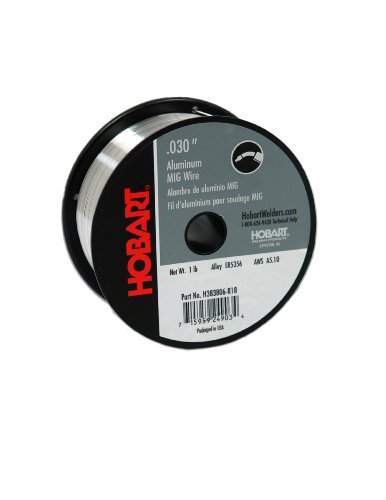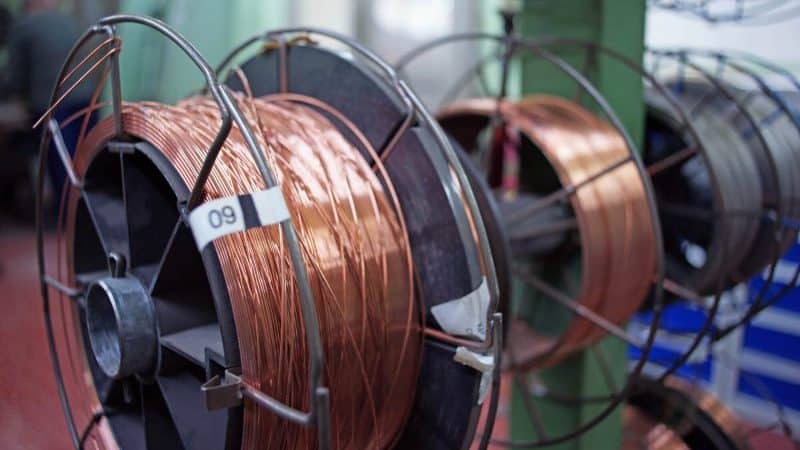MIG welding wire plays a huge role in both quality and ease of welding.
The wrong wire causes feed problems, jams the gun and wreaks havoc with your settings.
When it doesn’t make good welds, 10 pounds of poor quality wire is a waste of money. Don’t let this happen to you. Bad wire costs more than good wire in the long run.
We’ve sorted through the market, finding the best MIG wires to save you the grief.
To keep things equal, we looked at ER70S-6 mild steel wire, by far the most common use in the industry.
These choices are all 10-pound rolls. 2-pounders are available. These wires are all .030 size. Prices are similar for .035 wire size.
A Quick Comparison
| Product | |||
|---|---|---|---|
| Image | Product | Details | |

|
INEFIL ER70S-6 |
Copper-coated .030 wire Made in Italy using state of the art technology Low-spatter performance |
|

|
Lincoln SuperArc L-56 |
Copper coated .030 wire Premium quality Wire feeds reliably & burns consistently |
|

|
YESWELDER ER70S-6 |
Carbon steel wire in .030" & .035" Great for construction work Well reviewed by users |
|

|
Hobart ER5356 |
Aluminum wire in .030 & .035" For welding 5000 series aluminum base metals Excellent performance |
|

|
Harris E70S6E5 |
Copper coated .030 wire General-purpose welding wire for mild steel. Feeds smoothly |
Best MIG Welding Wire with Reviews
Here a list of some of the best MIG wires we found:
1. INEFIL ER70S-6 .030 MIG Wire

- Copper coated for easy feeding
- Premium wire made of high-quality steel
- High technology process control
- Manganese and silicon deoxidizers for dirty steel
- Made in Italy since 1950
Pros
- Known for low-spatter performance
- Great for single or multi-pass welding
- Wire unwinds well without crossing up
- Consistent diameter
- Users love its bead and penetration
Cons
- Sometimes hard to find in stock
- Doesn't meet US MilSpec standards
Overview
Users have a lot of good things to say about the INEFIL ER70S-6. There’s lots of praise from pro welders for great feed performance, good wetting and superior bead appearance, making for a lot less labor getting it pretty after you’re done welding. Welders praised this wire for its light coating of copper, which protects the wire from rusting, lubricates the feed performance and doesn’t flake off like thicker coating does.
The only thing that’s a drawback over the Lincoln wire is that the Inefil wire is made in Europe to EU standards, meaning if you’re doing government contract work, it won’t meet Buy America standards. However, this is a very high quality wire, and if you don’t have to demonstrate military or other safety certification or prove it originates in North America it will likely perform as well as any other wire on the market, probably better.
Inefil rates this wire for an 80 percent argon/20 percent CO2 mix, but the American Inefil representative says it also works great with 75 percent AR/25 percent CO2, which can save a little money on the gas bottles.
2. Lincoln SuperArc L-56 .030 MIG Welding Wire

- Copper coated for better feed quality
- Consistent diameter through the whole spool
- High manganese and silicon content
- Handles medium to heavy mill scale
- Meets military and shipbuilding standards
Pros
- Lincoln's premium grade wire
- Chemical quality control, not heat samples
- Meets US standards, surpassing EU grades
- Works for short-circuit and spray methods
- Superior wetting performance
Cons
- Costlier than the competition
Overview
We selected Lincoln SuperArc as our Pro Choice because it’s the most-used wire in the welding industry for mission-critical applications. When the work needs to meet military standards or Lloyd’s Registry shipbuilding requirements, Lincoln SuperArc is the most-chosen wire. NASCAR, Formula 1 and NHRA racing teams use Lincoln wire to build safety cages and it’s also the choice of roller coaster and thrill ride manufacturers.
What is the difference with this wire? It’s not that it’s actually of better quality. The difference is the level of process monitoring to ensure it meets extremely stringent standards like these.
For tasks like fixing washing machines or gate hinges, it’s not a big deal if your wire doesn’t meet Buy America standards or won’t satisfy the Lloyd’s Registry standards for tensile strength.
However, if you’re welding on a trailer tongue, suspension components or building a roll cage, you might appreciate the knowledge that this wire is certified and inspected for applications where safety is the top priority.
Many professionals also feel that this wire feeds the best and enables them to make the highest use of their hard-earned skills.
3. YESWELDER ER70S-6 .035 Mild Steel MIG Welding Wire

- Copper coating feeds well
- High manganese and silicon content
- Made to run on 100 percent CO2
- Good on steel with light rust or scale
- Available in .030" & .035"
Pros
- Users praise the feed quality
- Good splatter control
- Welds well with good penetration
- Consistent quality through the spool
Cons
- Hong Kong origins can't meet EU/US gov specs
Overview
Boulder, Colorado’s YesWelder is gaining a following among American welders with Hong Kong-sourced welders and equipment. Originally a supplier of third-party products, in 2018 it was sold and began directly sourcing its own helmets and welders from Hong Kong. Recently YesWelder started offering consumables, and it’s getting good reviews from US welders for the quality of its MIG welding wire.
This wire has a reputation for good feeding. Thin copper coating protects the wire from rust and helps smooth feeding through the torch liner. Users often comment on consistent quality through the entire spool, welding as well as more expensive American brands.
If you don’t need to meet military, government, racing body or marine requirements for certified processes, YesWelder wire will probably work fine for anything you need to do with a MIG welder.
We found no reports of spattering problems, crushed wire or inconsistent diameter along the length of the spool. Users report plenty of penetration and good strength in their welds and the material seems to be of good quality. Yeswelder has good marks for customer service from buyers.
4. Hobart ER5356 .030 Aluminum MIG Wire

- Excellent corrosion resistance for salt water
- 30-day warranty
- High shear strength
- 5356 alloy for 5000 series aluminum
- Uses 100 percent argon shielding gas
Pros
- Users report it feeds well
- Clean and solid welding
- Good wetting action
- Less prone to welds cracking
- Bright finish requires less cleanup
Cons
- Aluminum takes a teflon liner and argon gas
Overview
We decided it was appropriate to include at least one choice of aluminum wire for those wanting to weld aluminum but finding information scarce.
This is just about the best aluminum wire going. Most professionals prefer Hobart wire when it comes to welding aluminum. Hobart aluminum wires are heavily favored in marine welding because they’re very resistant to salt water corrosion.
This particular wire is 5356 alloy, the most versatile for welding 5000 series aluminum. Something with a little less silicon may provide a better wetting action for prettier beads, but 5356 has excellent shear strength for items like truck bumpers and tool boxes.
If you’re doing 6015, use 4043 wire for excellent results on high strength items like motorcycle handlebars, ski boat towers and that type of application.
You don’t want to chemically contaminate aluminum equipment with copper coating from steel wire, so you need to change the liner in the torch lead and use a spool gun to shorten the electrode distance. Change the torch tip and shield to clean items. Use separate clamps, brushes and other tools.
5. Harris E70S6E5 .030 MIG Welding Wire

- Copper coating makes for good feed
- Formulated to run on 100 percent CO2
- Manganese and silicon make dirty steel easy
- 11 pounds for the price of 10 pounds
- Designed for low spatter performance
Pros
- Users say it welds like the big names
- Harris is owned by Lincoln Electric
- Buyers report it feeds smoothly
- An extra pound for a great price
Cons
- Made in China, can't meet US or EU gov standards
Overview
Harris is a Lincoln Electric brand, suggesting that quality should be good because Lincoln has an industry-leading reputation to worry about.
However, if you need to meet US or European government or military standards it won’t qualify because it’s Chinese made. The same holds true when welding on marine vessels inspected under the Lloyd’s Registry.
That’s not to say the wire itself is of lesser quality, just that it isn’t certified to meet certain particular legally mandated inspection standards. That’s one reason it’s cheaper than highly inspected wires at the high end of the market.
Users overwhelmingly report good results with both welding and feeding from this wire. Many welders are very satisfied with its low spatter rate, especially at lower current settings with 100 percent CO2 versus a 75 percent argon/25 percent CO2 mix.
This wire does meet AWS standards for ER70S-6 quantities of silicon and manganese deoxidizing compounds. Users report great results on contamination like light rust or moderate mill scale.
This is a good, inexpensive alternative for repairing things like fencing, engine brackets and machinery.
MIG Wire Buying Guide
When you buy welding wire, check quality for strong, clean welds.
Use the right diameter for the thickness of metal and the correct alloy for the metal you’re welding. Use the right diameter torch tip to feed the wire.
Pro welders recommend using one size larger nozzle when feeding aluminum wire.
Unsure of the wire you need? Read: MIG wire types and specifications here.
Feed Quality
Each machine wears differently because a human uses it. Individual MIG machines and torch leads feed differently with different wires.
This is where reviews come in handy, along with opinions on welding forums. Look for wire with wide agreement on how well it feeds.
If wire jams in the lead, it can damage your liner, kink up the spool and break or wad the wire. These problems lower productivity and break your welder, costing you money.
Related: Recommended MIG Welding Pliers
Spatter and Flow
Spatter is small bits of metal that spray around the welding area. It’s usually not a big problem when doing gas MIG welding, but cheaper wires tend to produce spatter. You may need to run different settings than you would with higher quality wire.
Related: Causes of spatter and how to reduce it
Flow characteristics are important, too. Some wires make it easier to push or pull the weld puddle. Welders often describe “wetting” qualities of a wire in reviews or on forums. You’re looking for quick-melting wire, but with the predictable flow to work the puddle.
Note: you can also see our breakdown of the top 5 flux core wires here
Bottom Line
You want the wire that will do the job, period. If you can save a few bucks, that’s great, but welding is all about quality. Sometimes there’s no choice, like meeting certification standards for government, racing, or military work.
If you’re fixing stuff around the house or doing trailer work for a buddy, anything that satisfies you with its strength, safety, and quality is fine.
Because this article is about the best MIG wire, Weld Guru chose the finest wire we could find as our Pro-Choice. That’s Lincoln SuperArc L-56, as shown by its use in so many mission-critical applications.
